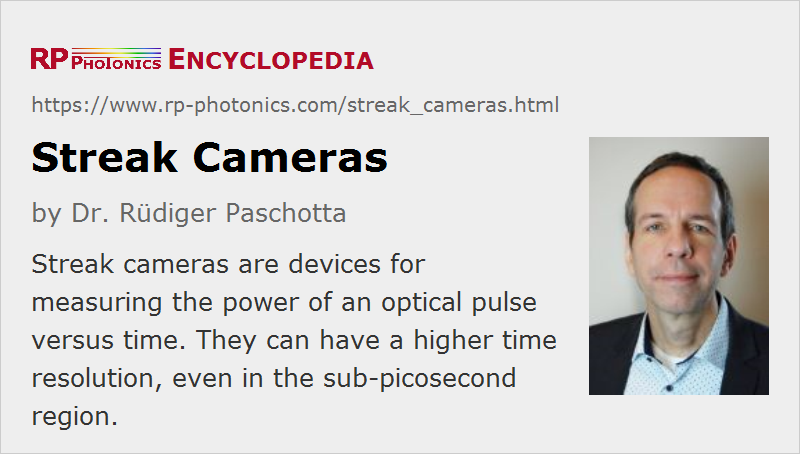Streak Cameras
Definition: devices for measuring the power of an optical pulse versus time
More general term: pulse characterization instruments
German: Schmierbild-Kamera
Category:  light detection and characterization
light detection and characterization
Author: Dr. Rüdiger Paschotta
Cite the article using its DOI: https://doi.org/10.61835/9ae
Get citation code: Endnote (RIS) BibTex plain textHTML
Streak cameras are devices for measuring the temporal evolution of the optical power or intensity of optical pulses. In contrast to other types of cameras, streak cameras are not imaging devices.
The basic principle of operation of a streak camera is that the incident light generates a spot which is rapidly deflected during some short time interval. The spatial distribution resulting from the moving spot (called the streak image) then reflects the temporal evolution of the optical power, since each temporal position is mapped to a spatial position. The streak image is a linear structure with varying light intensity, unlike an oscilloscope image, which is two-dimensional. It is often used for measuring the pulse duration and/or the peak power.
The simplest kind of streak camera is based on some means for deflecting an incident light beam – for example, a rotating mirror. Such devices are fairly limited in terms of temporal resolution because the speed of moving parts is limited.
The most common type of streak camera is an optoelectronic device, where the incident light hits a photocathode within a vacuum tube. Electrons emitted from that cathode are accelerated by a high-voltage, forming a pulsed electron beam, where the beam intensity is approximately linearly dependent on the optical intensity. That electron beam is deflected by an additional pair of electrodes, to which a rapidly varying electric voltage is applied. The electron beam can finally hit a phosphor screen for generating a visible streak image. Alternatively, the beam can hit a charge-coupled device (CCD) in order to obtain an electronic signal, which may be processed by a computer as in an digital oscilloscope; such a device may display a curve on a computer screen just as a digital oscilloscope does. The fastest optoelectronic streak cameras reach temporal resolutions of the order of 100 femtoseconds – however, only for rather weak input signals. For stronger signals, as needed for a higher signal-to-noise ratio, the temporal resolution is decreased due to the mutual repulsion of the electrons.
As in an oscilloscope, the deflection mechanism in a streak camera needs to be precisely triggered at a suitable time, e.g. just before a short optical pulse hits the photocathode. Both single-shot operation and repetitive operation can be realized; the latter is often desired for use with a mode-locked laser, for example.
For pulses with shorter durations, other devices are used for pulse characterization – for example, autocorrelators and setups for frequency-resolved optical gating (FROG) or spectral phase interferometry (SPIDER). Even for longer optical pulses, such methods have become more common, since they are easier to make (particularly autocorrelators) and partially allow for complete pulse characterization including the spectral phase (FROG and SPIDER), which cannot be measured with a streak camera. However, streak cameras have the advantage that their photocathodes can work in a very range of optical wavelengths; some streak cameras are even used for ultraviolet light or for X-ray pulses.
More to Learn
Encyclopedia articles:
Suppliers
The RP Photonics Buyer's Guide contains seven suppliers for streak cameras.
Questions and Comments from Users
Here you can submit questions and comments. As far as they get accepted by the author, they will appear above this paragraph together with the author’s answer. The author will decide on acceptance based on certain criteria. Essentially, the issue must be of sufficiently broad interest.
Please do not enter personal data here; we would otherwise delete it soon. (See also our privacy declaration.) If you wish to receive personal feedback or consultancy from the author, please contact him, e.g. via e-mail.
By submitting the information, you give your consent to the potential publication of your inputs on our website according to our rules. (If you later retract your consent, we will delete those inputs.) As your inputs are first reviewed by the author, they may be published with some delay.



Connect and share this with your network:
Follow our specific LinkedIn pages for more insights and updates: